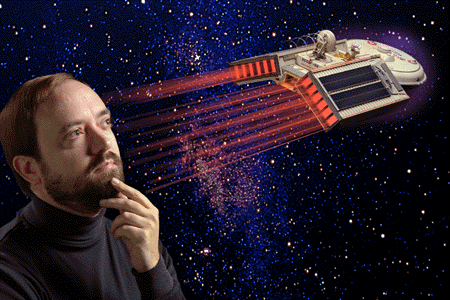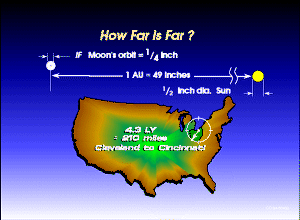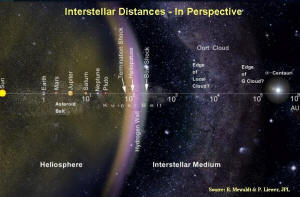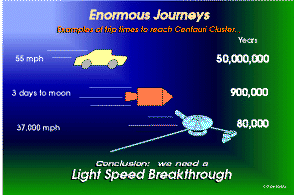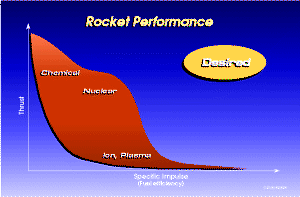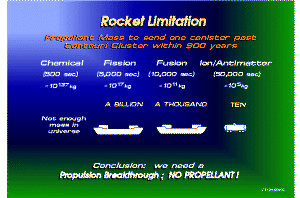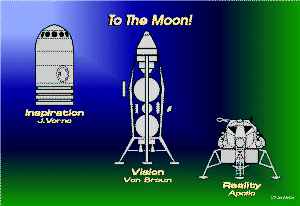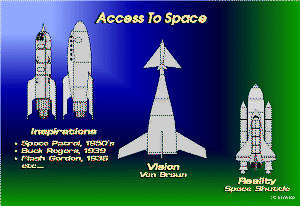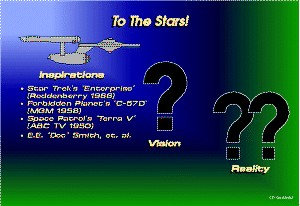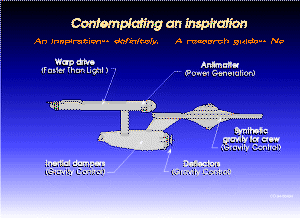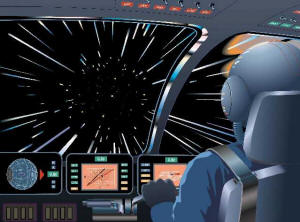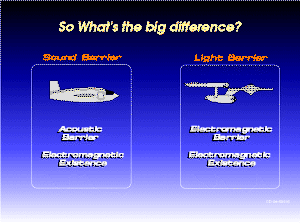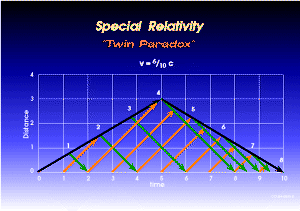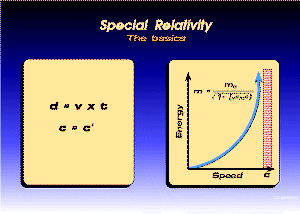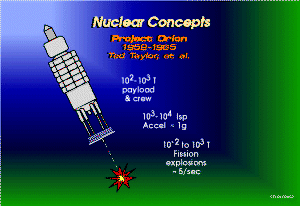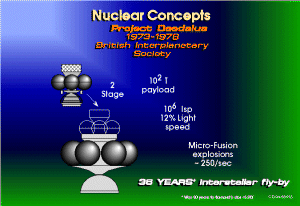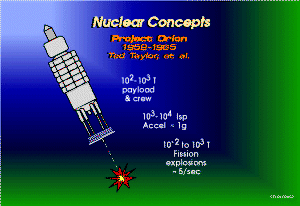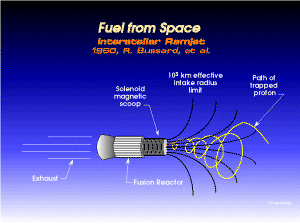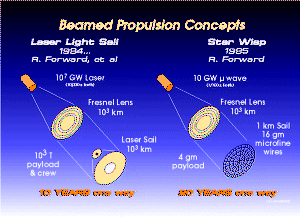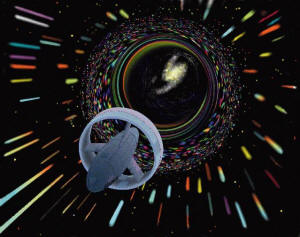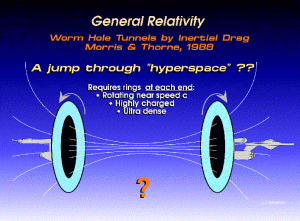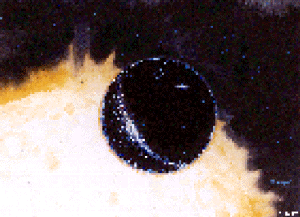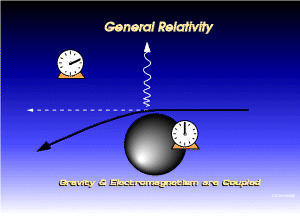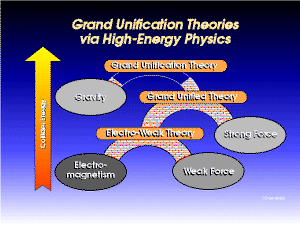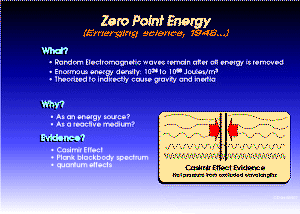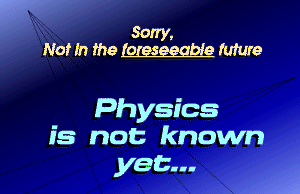|
|
|
from NASA Website
Have you ever wondered...
Have you ever wondered when we will be able to travel to distant stars as easily as in science fiction stories?
NASA Glenn's Marc Millis (pictured above), who has taken a break from Project Management for NASA's Breakthrough Propulsion Physics (BPP) Project to return to conducting research, offers this assessment of the prospects for achieving the propulsion breakthroughs that would enable such far-future visions of interstellar travel.
This web site focuses on the propulsion related issues, explaining the challenges of interstellar travel, existing propulsion ideas, and the possibilities emerging from scientific literature that may one day provide the desired breakthroughs.
To simplify the presentation for the general public, analogies to familiar science fiction are used.
This report is intended for public audiences, whereas researchers might want to check out the Breakthrough Propulsion Physics Project web site.
A Look at the Scaling
The ideal interstellar propulsion system would be one that could get you to other stars as quickly and comfortably as envisioned in science fiction.
Before this can become a reality, three scientific breakthroughs are needed: discovery of a means to exceed light speed, discovery of a means to propel a vehicle without propellant, and discovery of a means to power such devices.
Why? - Because space is big, really, really, really big.
Space takes up a lot of space!
Interstellar distances are so astronomical (pun intended) that it is difficult to convey this expanse. Consider the following analogy: If the sun were the size of a typical, 1/2 inch diameter marble, the distance from the sun to the Earth, called an "Astronomical Unit (AU)" would be about 4 feet, the Earth would be barely thicker than a sheet of paper, and the orbit of the Moon would be about a 1/4 inch in diameter.
On this scale, the closest neighboring star is about 210 miles away.
That's about the distance from Cleveland to Cincinnati.
How
Far is Far?
To help put this in perspective, consider that it takes light over 8 minutes to cover that 4 ft "Astronomical Unit" mentioned before.
Light is the fastest thing that we know to exist! Just imagine...How long will take you to travel 210 miles if it takes you over 8 minutes to travel just 4 feet? Actually, the answer is 4.2 years.
Our nearest neighboring star, Proxima Centauri, is 4.2 Light Years away.
Interstellar Distances - In Perspective
The Voyager spacecraft left the solar system at 37,000 miles per hour. At that speed, it would take Voyager 80,000 years to reach Proxima Centauri.
Speed: Getting there in a reasonable time - an obvious challenge
Enormous Journeys
The most obvious challenge to practical interstellar travel is speed. Our nearest neighboring star is 4.2 Light Years away.
Trip times to reach our nearest neighboring star at conventional speeds would be prohibitively long. At 55 miles-per-hour for example, it would take over 50 million years to get there! I don't think even the twinkies in the glove box would survive that long.
At a more typical spacecraft speed, for example the 3-day trip time that it took the Apollo spacecraft to reach the moon, it would still take over 900 thousand years.
I still don't think the twinkies will make it.
And even if we consider the staggering speed of 37-thousand miles-per-hour, which was the speed of the NASA Voyager spacecraft as it left our solar system years ago, the trip would still take 80,000 years.
Maybe the twinkies would make it, but there would be nothing left on board to eat them.
In conclusion, if we want to cruise to other stars within comfortable and fundable time spans (say, less than a term in Congress), we have to figure out a way to go faster than light.
Mass: Rockets use too much propellant - a less obvious challenge
A less obvious challenge is overcoming the limitations of rockets.
The problem is fuel, or more specifically, rocket propellant. Unlike a car that has the road to push against, or an airplane that has the air to push against, rockets don't have roads or air in space.
Today's spacecraft use rockets and rockets use large quantities of propellant. As propellant blasts out of the rocket in one direction, it pushes the spacecraft in the other - Newton's third law.
The farther or faster we wish to travel, the more propellant we'll need. For long journeys to neighboring stars, the amount of propellant we would need would be enormous and prohibitively expensive.
Rocket Performance
This chart highlights two critical features of a rocket, Thrust and Specific Impulse.
Thrust is how much push a rocket can give. The higher up on the chart, the greater the push.
Specific Impulse can be thought of as a kind of fuel efficiency for rocket engines, analogous to the miles-per-gallon for cars. The farther right on the chart, the less propellant you'll need. It really has to do with how fast the fuel blasts out of the rocket.
What you should notice is the red region.
This is the range of rocket performance we can conceivably create with what we know today. And what we need for interstellar travel is in that desired region or even more fuel efficient.
Here are four examples [image below] of what it would take to send a canister about the size of a Shuttle payload (or a school bus) past our nearest neighboring star... and allowing 900 years for it to make this journey.
Well.... If you use chemical engines like those that are on the Shuttle, well..., sorry, there isn't enough mass in the universe to supply the rocket propellant you'd need.
So let's step up to next possibilities, nuclear rockets with a predicted performance that's 10 to 20 times better!
Well...it's still not looking all that good. For a fission rocket you would need a BILLION SUPERTANKER size propellant tanks to get you there, and even with fusion rockets you would still need a THOUSAND SUPERTANKERS!
Even if we look at the best conceivable performance that we could engineer based on today's knowledge, say an Ion engine or an antimatter rocket whose performance was 100 times better that the shuttle engines, we would need about ten railway tanker sized propellant tanks.
That doesn't sound too bad, until you consider that we didn't bring along any propellant to let us stop when we get to the other star system... or if we want to get there quicker than 9 centuries.
Once you add the desire to actually stop at your destination, or if you want to get there sooner, you're back at the incredible supertanker situation again, even for our best conceivable rockets.
In conclusion, we'd really like to have a form of propulsion that doesn't need any propellant!
This implies the need to find some way to modify gravitational or inertial forces or to find some means to push against the very structure of spacetime itself.
Energy - yet another challenge
Our third big challenge is energy. Even if we had a non-rocket space drive that could convert energy directly into motion without propellant, it would still require a lot of energy.
Sending a Shuttle-sized vehicle on a 50 year one-way trip to visit our nearest neighboring star (subrelativistic speed) would take over 7 x 10^19 Joules of energy.
This is roughly the same amount of energy that the Space Shuttle's engines would use if they ran continuously for the same duration of 50 years.
To overcome this difficulty, we need either a breakthrough where we can take advantage of the energy in the space vacuum, a breakthrough in energy production physics, or a breakthrough where the laws of kinetic energy don't apply.
From Inspirations to Inventions
Fun Retrospectives & The Future
Right now we don't even know if practical interstellar travel is possible.
Just because we don't know how to do something today, however, doesn't mean that it is impossible. There is a historical pattern that has emerged where the grand visions of yesterday's science fiction inspired today's reality.
Maybe the same will happen with today's science fiction.
Here are examples:
To the Moon
A long time ago, Jules Verne wrote a story about sending people to the moon by blasting them out of a giant cannon.
That story inspired a whole host of rocketry pioneers who pondered how to make such a journey a reality. Based on the science of their day, they were eventually able to create visions of how to achieve such a feat - using rockets instead of cannons.
And, when all the conditions were right, these visions evolved into reality.
Now, we look back over 25 years to our landing people on the moon and bringing them back safely.
Access to Space
This next example is about routine access to space. In this case the inspirations were from Buck Rogers and Flash Gordon stories with their rockets gallivanting across space as routinely as that era's aircraft flew in the air.
Again, such stories inspired rocketry pioneers who created visions, and reality followed. In this case the Space Shuttle.
To the Stars
And now the inspirations behind this web page - Journeys to the stars.
The idea of "Warp Drives" and "Hyper Space" date back to the 1930's and are attributed to John Campbell. Another appropriate example is the 1956 movie "Forbidden Planet."
Its opening sequence has a prediction of how humanity conquers gravity and then goes on to discover how to exceed light speed. And a very well known example is, of course, Star Trek.
But today, we don't even have the scientific principles from which to create the visions.
First we need to develop such science and then we can engineer the visions and shape them into reality.
Contemplating an Inspiration
Because of its widespread familiarity, Let's examine the Star Trek inspirations.
By that we mean that there is not enough substance behind these vehicles and the techno-speak that is used to describe them that you could begin a research program.
They are however, inspirational, and they do provide mental pictures that make it easier to contemplate how you might achieve such feats.
This inspiration shows some of the features we would need for our interstellar craft.
A ruler for advancement Or, Where do we stand today?
This ruler measures how close we are to having this feature as a normal part of our lives.
Status of "Warp Drive"
"Warp Drives", "Hyperspace Drives", or any other term for Faster-than-light travel is at the level of speculation, with some facets edging into the realm of science.
We are at the point where we know what we do know and know what we don't, but do not know for sure if faster than light travel is possible.
The bad news is that the bulk of scientific knowledge that we have accumulated to date concludes that faster than light travel is impossible.
This is an artifact of Einstein's Special Theory of Relativity. Yes, there are some other perspectives; tachyons, wormholes, inflationary universe, spacetime warping, quantum paradoxes... ideas that are in credible scientific literature, but it is still too soon to know if such ideas are viable.
One of the issues that is evoked by any faster-than-light transport is time paradoxes: causality violations and implications of time travel.
As if the faster than light issue wasn't tough enough, it is possible to construct elaborate scenarios where faster-than-light travel results in time travel.
Time travel is considered far more impossible than light travel.
What's the Big Difference?
Ever since the sound barrier was broken, people have been asking:
It is too soon to tell if the light barrier can be broken, but one thing is certain - it's a wholly different problem than breaking the sound barrier.
The sound barrier was broken by an object that was made of matter, not sound.
The atoms and molecules that make up matter are connected by electromagnetic fields, the same stuff that light is made of. In the case of the light speed barrier, the thing that's trying to break the barrier is made up of the same stuff as the barrier itself.
How can an object travel faster than that which links its atoms?
Like we said, it's a wholly different problem than breaking the sound barrier.
Special Relativity
Here is a snap shot of the theory that sums up the problem:
Actually Special Relativity is pretty simple in its construction...
Just start with 2 simple rules:
When you combine these together and compare what one traveler "sees" relative to another traveler at a different speed - that's when the problems come into play.
Let me give you another way to picture this.
Close your eyes. Imagine that the only sense that you had was the sense of hearing. All that you know is sounds. You identify things by how they sound.
So when a train goes by, did its horn really change?
We know that the horn was always tooting the same tone, but it was the train's motion that made it appear to change because of something called the Doppler shift.
Its a similar situation with light. Everything we know around us we know by light, or more generally electromagnetism.
What we see, what we feel (the air molecules bouncing off our skin), what we hear (air molecules bouncing off each other in waves of pressure), even the propagation of time, are all governed by electromagnetic forces.
So when we start moving at speeds approaching the speed by which we are getting all our information, our information gets distorted. In principle it's that simple.
Understanding it well enough to do something about it, well that's a different matter.
Light Speed Barrier
One of the consequences of this Special Relativity is the light speed barrier. Here's another way to look at it.
To move faster, you add energy. But when you get going near the speed of light, the amount of energy you need to go faster balloons to infinity!
To move a mass at the speed of light would take infinite energy.
It appears that there is a distinct barrier here.
Status of Gravity Control
If you could control gravity or inertial forces, you would have a propulsion breakthrough (thrusting without rockets), a means to create synthetic gravity environments for space crews, a means to create zero-gravity environment on Earth - hey that could be fun - and a whole host of other things.
Like "Warp Drives", this subject is also at the level of speculation, with some facets edging into the realm of science.
We are at the point where we know what we do know and know what we don't, and there is a lot that we don't know. The better news is that there is no science that says that gravity control is impossible.
First, we do know that gravity and electromagnetism are linked phenomena.
We are quite adept at controlling electromagnetic phenomena, so one can presume that such a connection might eventually lead to using our control of electromagnetism to control gravity. General Relativity, another one of Einstein's doings, is one way to describe such connections.
Another way is through new theories from quantum mechanics that link gravity and inertia to something called "vacuum fluctuations."
Status of Antimatter
Antimatter is real stuff, not just science fiction. Antimatter is firmly in the realm of science with some aspects even entering the technology realm.
There is also a lot of speculation about what one might do with antimatter.
Status of "Transporters"
Transporters are only at the very first step of evolution. - conjecture. We know what we'd like to accomplish, but we haven't got a clue what physics we'll even need to learn about.
The closest topic to a transporter that we do have some understanding of is wormholes.
Ideas Based On What We Know
The following section has a brief description of some ideas that have been suggested over the years for interstellar travel, ideas based on the sciences that do exist today.
Project Orion
The first example is from the 1950's-60's, Project Orion - which offered to use nuclear bombs for a constructive purpose - space travel.
About 5 bombs per second are dropped out the back and detonated to propel the craft along. A huge shock plate with shock absorbers make up the base of the craft.
Experiments using conventional explosives were conducted to demonstrate the viability of this scheme. Although this vehicle was conceived to take a crew to Mars, it can also be considered for sending smaller probes to the stars.
This project ended with the nuclear test ban treaty in the 60's.
Project Daedalus, British Interplanetary Society
In the late 1970's the British Interplanetary Society revisited the Orion propulsion concept (below image), but at a more reasonable scale and for in-space use only.
Project Daedalus was a design study for sending a probe past Barnard's star with a 50 year trip time. (Barnard's star is about 6 Light Years away.)
In this case it used micro fusion explosions which relied on obtaining the appropriate fuel isotope from Jupiter that it scooped up on its way out of the solar system - tricky.
Bussard Interstellar Ramjet
Well, rather than bring your fuel along, why not get it as you go.
This Bussard Interstellar Ramjet concept, from the 1960's, relies on scooping up the lonely protons that drift in interstellar space, and then somehow getting them to fuse to make a nuclear rocket.
There are a variety of limitations to this concept, such as how many protons can be scooped up, the drag created from scooping them, and, not to mention, the feat of getting these protons to engage in nuclear fusion for a rocket.
Robert Forward's interstellar laser sails
Light sails are another possibility. Rather than use rockets, why not use light. When light strikes an object, it pushes on it ever so slightly. Use lots of light over a very large area, and the forces get noticeable. That is the idea here.
Robert Forward proposed using a 10-million-gigawatt laser to shine through a thousand kilometer Fresnel lens onto a thousand kilometer sail.
With these numbers, it is claimed that one could send a thousand-ton vehicle with crew to our nearest star in 10 years!
So, Forward revised the concept to more reasonable power levels.
This time it only has a 10-gigawatt microwave laser (still a feat unto itself), and this time the vehicle is a frail 16 grams of fine wires spread over just one kilometer. The sail has all its sensors and stuff built right into its array of wires.
This and similar concepts are still under investigation.
Significant advances are still required, however, before we can create such systems and before we have a sufficiently robust space program that could put them in space.
Ideas Based On What We'd Like To Achieve
The following section has a brief description of some ideas that have been suggested over the years for interstellar travel, ideas based on the sciences that do exist today.
Worm Hole transportation
Just when you thought it was confusing enough, those physicist had to come up with wormholes.
Here's the premise behind a "wormhole."
Although Special Relativity forbids objects to move faster than light within space-time, it is known that space-time itself can be warped and distorted.
It takes an enormous amount of matter or energy to create such distortions, but distortions are possible, theoretically.
To use an analogy:
In the case of the wormhole, a shortcut is made by warping space (folding the paper) to connect two points that used to be separated. These theories are too new to have either been discounted or proven viable.
And, yes, wormholes do invite the old time travel paradox problems again.
Here's one way to build one:
There are other ideas out there too - ideas that use "negative energy" to create and to keep the wormhole open.
Here's what a naturally occurring wormhole might look like if it passed in front of another star. This painting (above) is from Pat Rawlings.
Here's the premise behind the Alcubierre "warp drive":
To use an analogy, imagine you are on one of those moving sidewalks that can be found in some airports. The Alcubierre warp drive is like one of those moving sidewalks.
Although there may be a limit to how fast one can walk across the floor (analogous to the light speed limit), what about if you are on a moving section of floor that moves faster than you can walk (analogous to a moving section of space-time)?
In the case of the Alcubierre warp drive, this moving section of space-time is created by expanding space-time behind the ship (analogous to where the sidewalk emerges from underneath the floor), and by contracting space-time in front of the ship (analogous to where the sidewalk goes back into the floor).
The idea of expanding space-time is not new. Using the "Inflationary Universe" perspective, for example, it is thought that space-time expanded faster than the speed of light during the early moments of the Big Bang.
So if space-time can expand faster than the speed of light during the Big Bang, why not for our warp drive?
These theories are too new to have either been discounted or proven viable.
[Our gratitude to Michael Pfenning for pointing out an error in our older explanation of the Alcubierre warp drive.]
It has been shown that is theoretically possible to create a continuously propulsive effect by the juxtaposition of negative and positive mass and that such a scheme does not violate conservation of momentum or energy.
A crucial assumption to the success of this concept is that negative mass has negative inertia.
Their combined interactions result in a sustained acceleration of both masses in the same direction. This concept dates back to at least 1957 with an analysis of the properties of hypothetical negative mass by Bondi, and has been revisited in the context of propulsion by Winterberg and Forward in the 1980's.
Regarding the physics of negative mass, it is not known whether negative mass exists or if it is even theoretically allowed, but methods have been suggested to search for evidence of negative mass in the context of searching for astronomical evidence of wormholes.
A "space drive" can be defined as an idealized form of propulsion where the fundamental properties of matter and space-time are used to create propulsive forces anywhere in space without having to carry and expel a reaction mass. Such an achievement would revolutionize space travel as it would circumvent the need for propellant.
A variety of hypothetical space drives were created and analyzed by Millis to identify the specific problems that have to be solved to make such schemes plausible.
These hypothetical drives are just briefly introduced here.
Please note that these concepts are purely hypothetical constructs aimed to illustrate the remaining challenges. Before any of these space drives can become reality, a method must be discovered where a vehicle can create and control an external asymmetric force on itself without expelling a reaction mass and the method must satisfy conservation laws in the process.
[Note: This section is excerpted from Millis' "Challenge to Create the Space Drive," in the AIAA Journal of Propulsion and Power, Vol.13, No.5, pp. 577-582, Sept.-Oct. 1997. This 6 page report uses 7 hypothetical space drive concepts to highlight the unsolved physics and candidate next steps toward creating a propellantless space drive. It also contains figures for each concept which are not currently available electronically.]
Some Emerging Possibilities
The following section has a brief description of some ideas that have been suggested over the years for interstellar travel, ideas based on the sciences that do exist today.
Lists of Some Intriguing Emerging Physics
Science and technology are continuing to evolve. In just the last few years, there have been new, intriguing developments in the scientific literature.
Although it is still too soon to know whether any of these developments can lead to the desired propulsion breakthroughs, they do provide new clues that did not exist just a few short years ago.
A snapshot of just some of the possibilities is listed below:
Lists of some preparatory propulsion research
These emerging ideas are all related in some way to the physics goals for practical interstellar travel; controlling gravitational or inertial forces, traveling faster-than-light, and taking advantage of the energy in the space vacuum.
Even though the physics has not yet matured to where "space drives" or "warp drives" can be engineered, individuals throughout the aerospace community and across the globe have been tracking these and other emerging clues.
Most of this work has been fueled purely from the enthusiasm, talent, and vision of these individuals, but on occasion, there has been small support from their parent organizations.
Surveys & Workshops:
Theory:
Experiments:
General Relativity
This is a snap shot of how gravity and electromagnetism are known to be linked. In the formalism of general relativity this coupling is described in terms of how mass warps the space-time against which electromagnetism is measured.
These observations and the general relativistic formalism that describes them are experimentally supported.
Although gravity's effects on electromagnetism and space-time have been observed, the reverse possibility, of using electromagnetism to affect gravity, inertia, or space-time is unknown.
"Grand Unification Theories"
|


